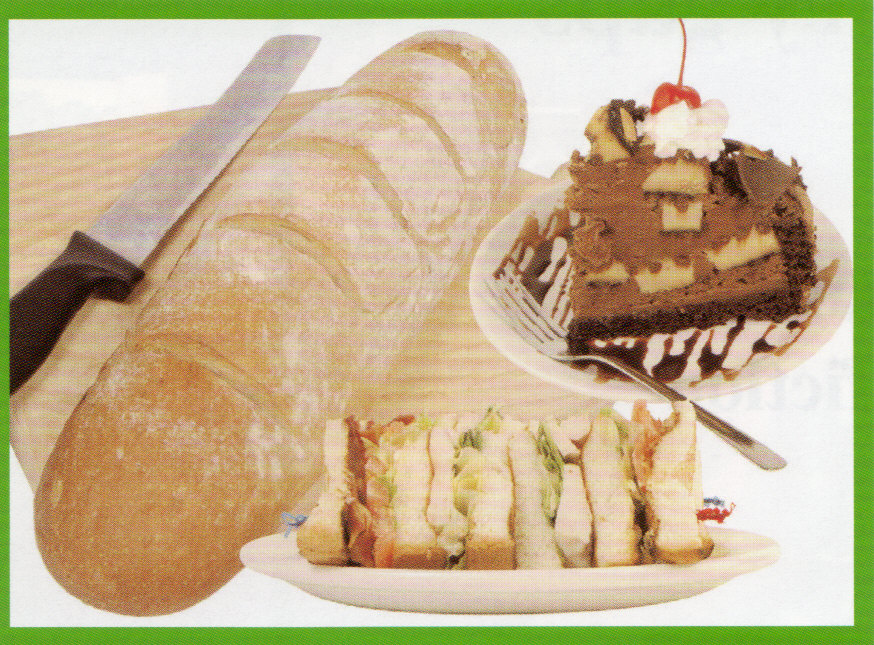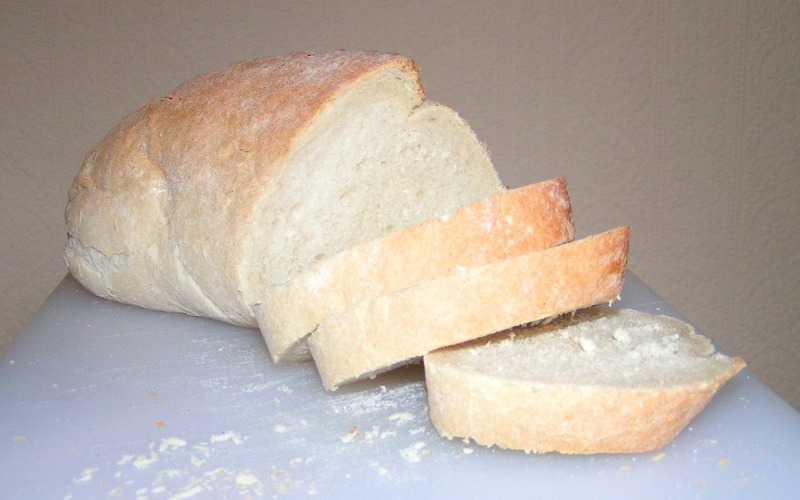
What You Should Know
About Refined Grains
There is a jingle that goes like this, "The whiter the bread the sooner you're dead!"
Bread has been termed the "staff of life" but in the form most of us eat this staple, it contains virtually no nutritive properties, cannot support animal life, and are full of chemicals.
"Fortified" grain products are useless and deceptive.
In America wheat is king, but after being milled it is seldom utilized in its whole form with its components intact.
Invariably, when we eat wheat we get it in the form of bread, pies, cakes, cookies, biscuits, spaghetti, cream of wheat, cereals and other forms and it has been treated, heated, fractioned, fragmented, and it would be next to impossible to recognize it for what it was originally.
What Are Refined
Grains?
A refined grain, or its product, is made by processing a natural whole grain so that some of its nutrients are lost. Flours, breads, cereals,noodles, pastries--almost all grain products have been refined in some way or another.
White rice cream of wheat, a cookie, poptarts, the bowl of snap-crackle-and-pop each morning--all are examples of refined grain products.
Why Are Refined
Grains Harmful?
Refined grains and their food products are substandard foods for several reasons:
1. They are excessively starchy.
2. They are practically devoid of natural fiber.
3. There are approximately 25 different chemicals that can be and are added to refined grains and breads.
4. Grains are fumigated.
5. They are "enriched" with synthetic vitamins.
6. Bleaching chemicals are used.
7. Artificial colorings and flavorings are used.
And perhaps most important of all, refined grain products are nutritionally imbalanced. It is because of the imbalance that these foods are responsible for degenerative diseases. Calcium leaching from the bones and the teeth occur because of the altered phosphorus-calcium balance in these products are primarily responsible for all tooth decay in this country, as well as the major cause of brittle bones in the elderly.
In natural organic foods that are eaten in their whole and unprocessed state, all the elements for proper nutrition are in their proper balance. this balance is completely destroyed in the refining process of grains.
A Loaf Of Chemicals
At the end of World War two, the making of bread and flour products took a real turn for the worse. Bakeries in America began using large amounts of chemicals, new addatives, new additives, bleaches and preservatives.
Even refined flour still has natural yellow pigments (such as carotene--a precurser of vitamin A). The millers discovered they could remove this color and make their flour even whiter by bleaching it. They started blowing chlorine gas into the flour after it was milled.
Chlorine gas, a deadly poison if inhaled, not only bleaches the flour but also reacts with other molecules in the flour. Many potentially toxic chlorinated lipid compounds are formed from this chlorine gas, such as dichlorostearic acid.
Chlorine also destroys major portions of vitamin E as well as an important amino acid in the bread protein, methionine (which is classified as “essential” for human nutrition).
Some psychiatrists claim that bleached flour may contribute to mental diseases.
It is believed that the tremendous increase of mental disease among Americans is due to bread made with bleached flour. Chlorine gas was found to be definitely toxic to laboratory animals.
Other chemical oxidizers are added to bleach and mature the flour, such as nitrogen dioxide, bencoyle peroxide, potassium bromate, potassium iodate, azocarbonamide. ARE THEY DANGEROUS? Well, Germany banned all such oxidizers back in 1958, almost 40 years ago!
FRESH “SQUEEZABLE”
BREAD
The next step in the chemicalization in bread is to add chemical dough conditioners to the dough to enable the resulting bread to retain its freshness and softness for a longer period, without getting stale while standing on grocers’ shelves.
To give this softness and white-bread texture, mono- and diglycerides are added to the bread dough at the rate of about ¼ pound per year per person consumption.
The effect is to make the bread more “plastic” or squeezable —nobody knows the effect on those that eat such additives.
But some of the chemicals used as dough conditioners are similar to the anti-freeze mix used for automobile radiators. One of the chemicals used as a dough conditioner is polyexy ethelyne monosterate. Workers in factories where this chemical is made have been known to develop skin rashes, even from the fumes. Polyexy ethelyne monosterate is also used in making peanut butter, ice cream, candy, and salad dressings.
The average person eats about 100 pounds or so of commercial bread each year. Besides eating the refined flour, the average person also eats such things as 2 pounds of salt, 3 pounds of sugar, 2 pounds of skim milk powder, 2 pounds of yeast, 1 pound of “enzyme activator,” ½ pond of sulfate, chloride and bromate chemicals, and ¼ pound of other food additives. When all these chemical and nonfoods are eaten together, a multi-toxic effect occurs that has never been thoroughly studied by scientists. Surely the cumulative effect on daily intake of such chemicals present in baker’s bread must be definitely disease- producing in time.
“ENRICHMENT” WITH
SYNTHETIC VITAMINS
Television commercials tell us that if we eat one cup of this or that specially fortified cereal, we’ll get 100% of almost all our vitamin and mineral requirements. They don’t tell you that these vitamins are inorganic fillers and additives which have been laced through a sugar coated product that is destructive to our health and well- being.
Over twenty vitamin and mineral elements are removed when whole wheat is converted into white flour, yet only four or five are replaced by enrichment, and are supplied in an inferior synthetic form, which the body cannot use and which does more harm than good.
Synthetic vitamins are coal tar products; and coal tar products are suspected of being cancer-producing. They are products of the chemical laboratory or factory and cannot replace the natural vitamins that are formed in grains while growing on the open field in the sunshine.
The cereal manufacturers do not tell us that they also add these synthetic vitamins because all the original nutrients in the grain have been heated, rolled , puffed, squeezed and sugared out of existence. The vitamins and minerals are added so the manufacturers can justify the prices they charge for a product that is slightly more nutritious than the box it comes in.
“EXOTIC
CHEMICALS
IN FOOD”
Emanuel Kaplan and Ferdinand A. Dorf,
researchers with the Health Department in Baltimore, presented a report at a FDA meeting.
They stated:
“Let us quickly consider the chemical treatment of the various ingredients used in bakery practice. The flour is derived from seeds probably treated for plant disease protection with organic mercurials or similar agents, and the seeds are planted on soil influenced by fertilizers.
Selenium (an extremely poisonous mineral substance) may be extracted from the soil. In milling, flour is treated with improvers, oxidizing agents such as persulfate, bromate,
iodate and nitrogen tricholoride, which affects protease activity and gluten properties.
“Bleaching agents such as oxides of nitrogen, chlorine and benzoly peroxide cover the yellow caotenoid pigment to colorless compounds
because of alleged consumer desire for white bread. Vitamins and minerals are added in compulsory “enrichment.” Mineral salts may be added to stabilize gas-retaining properties of flour gluten. Cynanide or chlorinated organic compounds may be employed in fumigation of the resulting flour in storage.
“The water used may be chemically purified by means of alum, soda ash, copper sulfate, and chlorine…. ammonium salts and other chemicals are employed as yeast nutrients. Chemical leaveners may contain sodium bicarbonate, alum, tartrates, phosphates, starch and cream of tartar. Fluorine is a possible natural contaminant of the phosphates…. Oleomargarine, if used, may have added color, vitamin A, neutralizers, interface modifiers and preservatives; or the margarine may be packed in a preservative treated wrapper.
Mineral oil is frequently used as a dough trough or pan lubricant….Milk or milk products may contain neutralizer or antioxidants…. Artificial coal tar color may be used…Stabilizers and thickeners such as gums and treated starches may be employed as fillers. Synthetic flavors used contain glycerine, alcohol or substitute chemicals as solvents for
a variety of alcohols, esters, acids, and ketones, and may contain saccharine. (Ed. Note: Today this is probably replaced with aspartame, an artificial sweetener widely used, and is known as an excitotoxin that can cause brain seizures and other neurological diseases.) Spices may be natural spices subjected to fumigants or solvent-extracted spice
essences. Mold inhibitors such as calcium propionate may be employed and the final product may be contaminate on the store shelf with insecticide powders such as sodium fluoride.” (Ed. Note: The labels on the cans of sodium fluoride manufactured by Merck & Company read:
“POISON—WARNING! MAY BE FATAL IF INHALED OR SWALLOWED.
Avoid breathing dust. Store away from food, and out of reach of children and domestic animals. Wash thoroughly after handling. Do not let sodium fluoride get into food or drink or into cuts or wounds. To avoid inhaling the dust, the user should cover the nose mouth with a wet cloth while applying.”)
IT USED TO BE A GRAIN OF
CORN
What is a cornflake? How is it made?
First, the kernels of corn are soaked in lye.
Lye is a caustic, corrosive substance that will burn skin off your body. It’s used in making rayon, soaps and—
breakfast cereals.
After the soaking, the kernels are blasted by live steam. Then a flavoring syrup full of mostly white sugar is poured over the soaked and steamed corn.
Next, the kernels are dried until they’re hard.
Then they are run though huge rollers that press down with 75 tons of pressure to flatten them out. Now they’re ready to be toasted, heated and flaked one more time. Then they get their last doing of preservatives, additives and chemicals and are packaged up in a brightly colored box.
OTHER REFINED GRAIN
PRODUCTS
Although most grains consumed in America is in the form of breads, cereals, or pasta, other products are used in large amounts. White rice
is generally polished whole rice. This polishing strips away many of the B vitamins and some of the protein—about the same thing that happens to refined wheat. White rice is a nutritionally unbalanced food and should never be eaten.
Pasta such as macaroni, spaghetti, noodles, etc. are usually made from semolina which is a refined white flour made from wheat. It too is like eating “white bread.”
For improved health, all refined flour products should be eliminated from the diet. Whole grain should only be used.
The crux of the situation is—the keeping qualities or shelf-life are far more important in our economy than
the health and well-being of the people.
Wheat before milling is treated with benzoyl chloride as a bleaching agent. Traces of this remain after the process and are a prime cause of allergy or intolerance.
Whether therefore ye eat, of drink, or whatsoever ye do, do all to the glory of God. 1Corinthians 10:31
Katy Chamberlin freedomofhealth.org
